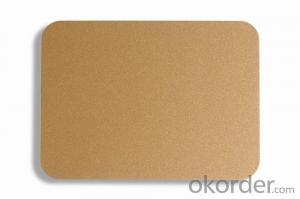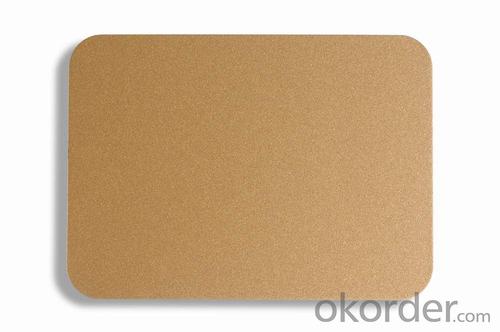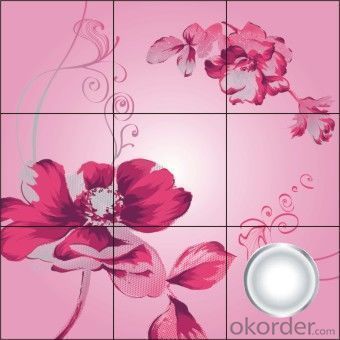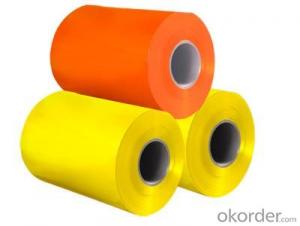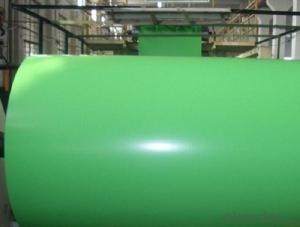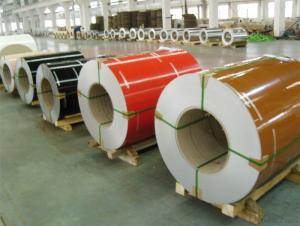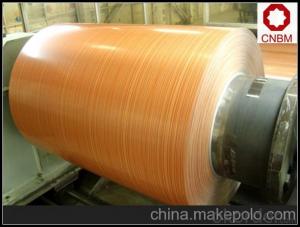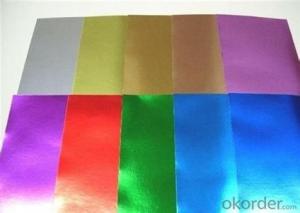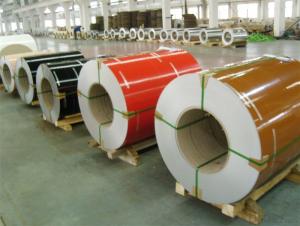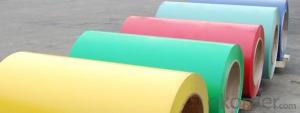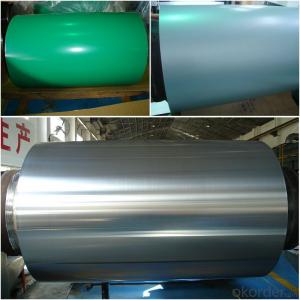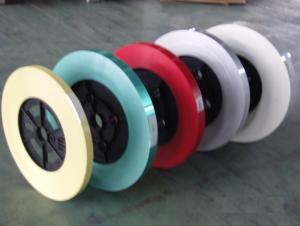Black and White PVDF/PE Coated Aluminum Coil
- Loading Port:
- Shanghai
- Payment Terms:
- TT OR LC
- Min Order Qty:
- 8 m.t.
- Supply Capability:
- 2000 m.t./month
OKorder Service Pledge
OKorder Financial Service
You Might Also Like
Specification
Structure of Aluminium Coated Coil with PVDF/PE Coating Description:
Coated aluminum coil/sheet are of a wide range of colors, which gives wonderful appearance no matter in residential and commercial constructions of great exhibition centers.
The coated aluminum coil/sheet have been widely used in the fields of construction and decoration( garage doors, ceiling etc.), electronic appliances, lighting decoration, air-condition air pipes, sandwich panels and drainages etc.
Main Features of the Aluminium Coated Coil with PVDF/PE Coating:
1) High flexibility
2) Impact resistance
3) Excellent weather-proof durability
4) Anti-ultraviolet
5) High erosion resist
Images of the Aluminium Coated Coil with PVDF/PE Coating:
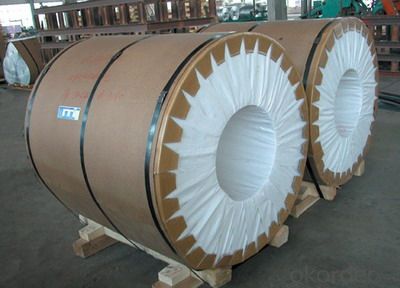
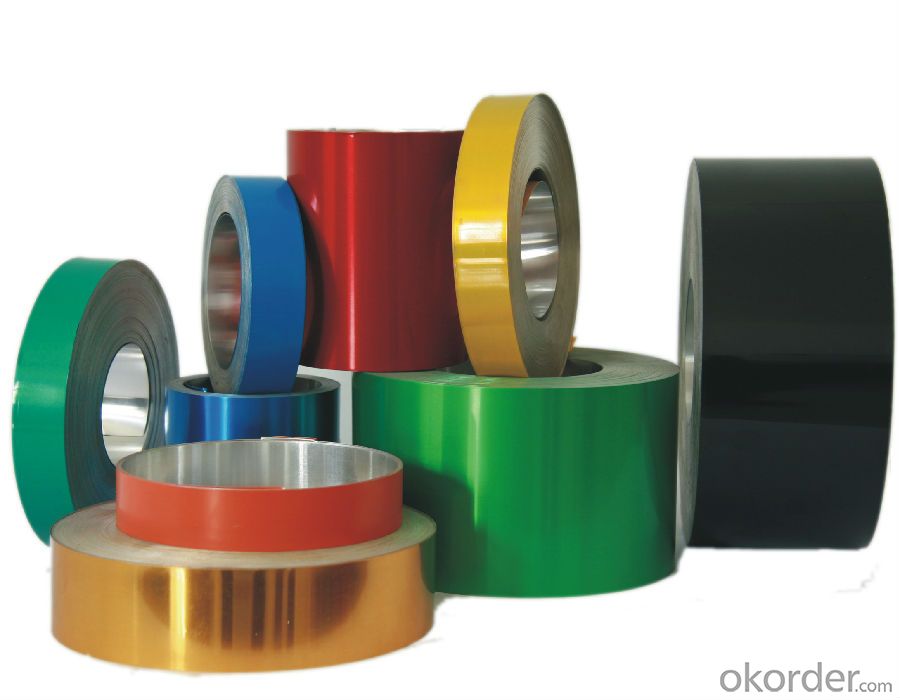

Aluminium Coated Coil with PVDF/PE Coating Specification:
Alloy | A1100,A3003,A1050,A8011 etc |
Temper | H16,H18,H24 |
Thickness | From 0.024mm to 1.2mm |
Width | Standard width:1240mm |
Special width:1300mm,1520mm,1570mm,1595mm | |
Diameter | Standard dia:1200mm |
Interior dia:150mm,405mm,505mm | |
Weight | 2.5 T/coil,3.0 T/coil |
Coating | PE, PVDF, AC |
Surface | Embossed, mill finish, coated |
Color | AS to code RAL |
Gloss | 10-90%(EN ISO-2813:1994) |
Coating Thickness | PE: more than 18 micron |
PVDF: more than 25 micron | |
Coating Hardness (pencil resistance) | More than 2h |
Coating adhesion | 5J(EN ISO-2409:1994) |
Impact Resistance | No peeling or cracking(50 kg/cm,ASTMD-2794:1993) |
Flexibility (T-bend) | 2T |
MEK resistance | More than 100 |
FAQ Aluminium Coated Coil with PVDF/PE Coating:
a.What is monthly capacity
---CNBM is one stated own company and our monthly capacity is about 2000tons.
b. Now which countries do you export your goods?
---Now we export to South East Asia,Africa, North America,South America ect.
- Q: What are the advantages of using aluminum coils?
- Using aluminum coils in various applications offers several advantages. To begin with, aluminum coils are known for their lightweight properties, distinguishing them from materials like copper or steel. Their reduced weight makes handling and transportation easier, ultimately decreasing the overall weight of the system or product in which they are utilized. Moreover, their lightweight nature contributes to simplified installation and maintenance procedures. Additionally, aluminum coils exhibit exceptional corrosion resistance. They naturally develop a protective oxide layer on their surface, preventing further oxidation and corrosion, even in harsh environments. This quality renders them particularly suitable for outdoor applications or areas exposed to high humidity or chemicals. Furthermore, aluminum coils possess high thermal conductivity, enabling efficient heat transfer. This characteristic proves valuable in heating, ventilation, and air conditioning (HVAC) systems, as it enhances energy efficiency and reduces overall energy consumption. In addition, aluminum coils demonstrate remarkable flexibility, allowing them to be easily formed into various shapes and sizes. This flexibility grants designers greater freedom and customization options, making aluminum coils suitable for a wide range of applications. They can be effortlessly bent, cut, or shaped to meet specific requirements without compromising structural integrity. Lastly, aluminum coils are cost-effective. Aluminum is abundant and readily available, making it more affordable compared to other materials. Moreover, its lightweight nature reduces transportation costs, while its corrosion resistance eliminates the need for frequent maintenance and replacements, resulting in long-term cost savings. To summarize, the advantages of using aluminum coils encompass their lightweight properties, exceptional corrosion resistance, high thermal conductivity, flexibility, and cost-effectiveness. These characteristics have established aluminum coils as a popular choice in various industries, including construction, automotive, aerospace, and HVAC.
- Q: How are aluminum coils priced?
- Aluminum coils are priced based on a variety of factors including the current market price of aluminum, the size and thickness of the coils, the quantity being purchased, and any additional customization or processing requirements. The market price of aluminum is influenced by factors such as supply and demand, global economic conditions, and trade policies. The size and thickness of the coils can affect the cost as larger or thicker coils generally require more raw materials and production time. The quantity being purchased can also impact the price, as larger orders may receive volume discounts. Additionally, if the coils require any additional customization or processing, such as coating or shaping, this can also impact the overall price. Overall, the pricing of aluminum coils is a complex process that takes into consideration various factors affecting the cost of production and market conditions.
- Q: Can aluminum coils be anodized?
- Indeed, it is possible to anodize aluminum coils. Anodizing, an electrochemical technique, enhances the existing oxide layer on the aluminum's surface, rendering it denser, sturdier, and more resistant to corrosion. This particular process finds widespread usage in aluminum sheets, plates, and coils. Anodizing can be effectively employed on both flat and shaped aluminum coils, imparting them with a plethora of appealing hues and finishes. Furthermore, the anodized coating significantly improves the aluminum's capacity to accommodate paint and adhesives, thereby rendering it a highly sought-after option for numerous applications, including architectural cladding, automotive trim, and electronic components.
- Q: Are aluminum coils available in custom sizes?
- Indeed, custom sizes for aluminum coils are readily obtainable. Aluminum coils exhibit great versatility and can be produced to satisfy particular size specifications. This adaptability enables their utilization in a diverse array of industries. Be it for HVAC systems, transportation, construction, or any other purpose, aluminum coils can be specifically tailored to suit the unique requirements of any given project. The provision of custom-sized aluminum coils guarantees an impeccable fit and outstanding performance, thereby promoting enhanced efficiency and cost-effectiveness.
- Q: How do aluminum coils contribute to improved indoor air quality?
- Various ways are improved by aluminum coils in enhancing indoor air quality. Primarily, these coils are commonly used in air conditioning and HVAC systems, which are designed for circulating and filtering the air inside buildings. The cooling and dehumidifying of the air, reducing moisture content that can encourage the growth of mold and mildew, is assisted by the aluminum coils in these systems. By controlling humidity levels, allergens and pollutants that thrive in damp environments are prevented from developing, thus enhancing indoor air quality. In addition, aluminum coils function as highly efficient heat exchangers, facilitating effective heat transfer between the air and the cooling or heating system. This efficiency enables HVAC systems to maintain a consistent temperature throughout the building, resulting in reduced energy consumption. Through the use of less energy, these systems emit fewer harmful greenhouse gases, ultimately contributing to lower levels of outdoor air pollution and improving overall air quality. Furthermore, the durability and resistance to corrosion of aluminum coils are essential for maintaining a clean and healthy indoor environment. The corrosion-resistant properties of aluminum coils ensure that no metallic particles or rust contaminate the circulated air. Consequently, occupants are less likely to inhale harmful particles that can cause respiratory issues and other health problems. Moreover, aluminum coils are lightweight and often come with a protective coating, making them easier to clean and maintain. Regular cleaning of coils prevents the accumulation of dust, dirt, and other pollutants over time. By keeping the coils clean, airflow is optimized, ensuring that the circulated air is free from contaminants and allergens, thus promoting improved indoor air quality. In summary, aluminum coils contribute to improved indoor air quality by reducing humidity levels, preventing the growth of mold and mildew, enhancing energy efficiency, minimizing the emission of greenhouse gases, and maintaining a clean and contaminant-free air circulation system. These coils are an essential component of HVAC systems that play a vital role in creating a healthier and more comfortable indoor environment for occupants.
- Q: What are the different coil winding options for aluminum coils?
- Aluminum coils have various options for winding, each with its own advantages and applications. 1. One option is layer winding, which involves winding the coil in a single layer. This method is cost-effective and suitable for applications that require high voltage or high current. 2. Another option is disc winding, where the coil is wound in a disc-like shape with layers stacked on top of each other. This technique allows for better heat dissipation and is commonly used in high-frequency applications. 3. Helical winding is a method that involves winding the wire in a spiral pattern around the coil form. This technique allows for a higher number of turns in a given space, resulting in increased inductance. It is commonly used in applications requiring high inductance. 4. Interleaved winding is a technique where multiple layers of coil windings are interleaved, with each layer wound in opposite directions. This method reduces the overall size of the coil and improves efficiency by reducing the proximity effect. 5. Foil winding involves using thin layers of aluminum foil instead of wire. This method offers better cooling and reduces the overall size of the coil. It is commonly used in high-power applications. 6. Sectional coil winding involves dividing the coil into sections and winding each section separately. This method allows for better control over the coil's shape and size, making it suitable for unique or irregularly shaped applications. The choice of coil winding option depends on factors such as desired electrical characteristics, space constraints, cooling requirements, and cost considerations. It is important to carefully analyze the requirements of the specific application before selecting the appropriate coil winding technique for aluminum coils.
- Q: Can aluminum coils be used in packaging industries?
- Yes, aluminum coils can be used in packaging industries. Aluminum is lightweight, flexible, and has excellent barrier properties that protect the packaged products from moisture, oxygen, and light. It is commonly used for packaging food, beverages, pharmaceuticals, and other consumer goods due to its durability and ability to preserve product quality.
- Q: Is it possible to utilize an aluminum coil for heating purposes?
- <p>Yes, aluminum coil can be used as a heater. Aluminum is a good conductor of heat, making it suitable for applications where heat transfer is necessary. However, it's important to note that aluminum has a lower melting point compared to other metals like copper or steel, so it's not ideal for high-temperature applications. Aluminum coils are commonly used in electric heaters, such as toasters and air heaters, where they can efficiently transfer heat to the surrounding air or materials. Always ensure that the aluminum coil is used within safe temperature limits to prevent damage or safety hazards.</p>
- Q: Does anyone know of any men's deodorant that doesn't contain aluminum? It has to be strong, as I do sweat a lot.
- Go to old spice there the best
- Q: Are aluminum coils suitable for food packaging?
- Food packaging can indeed utilize aluminum coils. Aluminum is extensively employed in the food packaging sector because of its various advantageous characteristics. To start off, aluminum serves as a non-toxic and non-reactive substance, ensuring that harmful substances do not leach into the food. Moreover, it acts as an impermeable barrier to gases and moisture, effectively safeguarding the food from oxygen, light, and moisture that could spoil its quality or alter its taste. In addition, aluminum coils are lightweight, facilitating their transportation and handling. They are also highly malleable, enabling them to be easily shaped and formed into various packaging designs. Additionally, aluminum's heat conductivity properties are commendable, allowing for efficient heat transfer during food processing or cooking. Finally, aluminum demonstrates its commitment to the environment as a sustainable and recyclable material, making it an eco-friendly choice for food packaging. Overall, due to its safety, barrier properties, lightweight nature, flexibility, heat conduction capabilities, and sustainability, aluminum coils are a suitable and widely embraced option for food packaging.
Send your message to us
Black and White PVDF/PE Coated Aluminum Coil
- Loading Port:
- Shanghai
- Payment Terms:
- TT OR LC
- Min Order Qty:
- 8 m.t.
- Supply Capability:
- 2000 m.t./month
OKorder Service Pledge
OKorder Financial Service
Similar products
Hot products
Hot Searches
Related keywords
